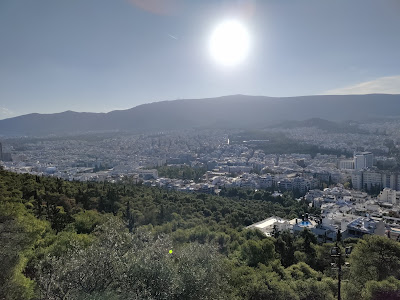Greece 17: Athens - The Big Picture.
During the Greek War of Independence Athens was a village of about 9,000. When it was declared the capital in 1831 it started to grow. Depending on how you define the city or metropolitan area it has 3 to 4 million people - a third or more of the nation's population.
It is a heck of a place to visit. The ancient and the modern bump up against each other in interesting ways. For example, the Parthenon, symbol of classical civilization, which pops into view from all over the city.
But you don't have to climb the Acropolis to be reminded that much of what we think of as Western civilization started here. We visited the neighborhood called Kerameikos, which is where the potters lived and worked. (Good clay here, and the neighborhood gave us the word ceramics.) There used to be a type of public architecture called a stoa, a wall-less colonnade, and one in this neighborhood was called the Royal Stoa. A group of philosophers used to hang out at that building and so they became known as the stoics. That's where the word comes from. See what I mean?
And, more humbly, in our hotel if you go downstairs to the fitness center you pass a glass wall. This is the sign you see there.
It is a heck of a place to visit. The ancient and the modern bump up against each other in interesting ways. For example, the Parthenon, symbol of classical civilization, which pops into view from all over the city.
But you don't have to climb the Acropolis to be reminded that much of what we think of as Western civilization started here. We visited the neighborhood called Kerameikos, which is where the potters lived and worked. (Good clay here, and the neighborhood gave us the word ceramics.) There used to be a type of public architecture called a stoa, a wall-less colonnade, and one in this neighborhood was called the Royal Stoa. A group of philosophers used to hang out at that building and so they became known as the stoics. That's where the word comes from. See what I mean?
Oh, they found the ruins of a house here with a sign that said it belonged to Simon. Socrates used to meet with his students at the house of Simon the potter. Same one? No way to know.
And, more humbly, in our hotel if you go downstairs to the fitness center you pass a glass wall. This is the sign you see there.
Now let's see some more of the sights.
Next stop: Athens - Approaching the Acropolis




.jpg)
Comments
Post a Comment